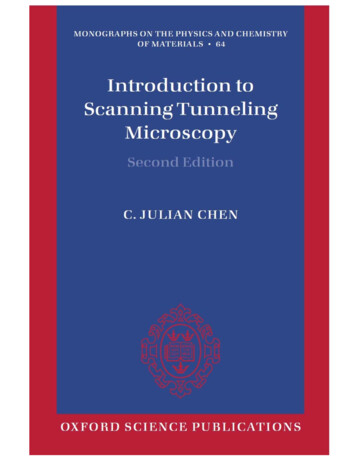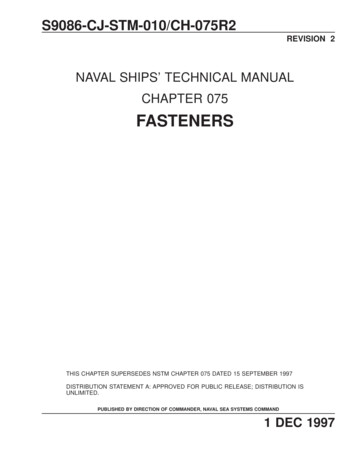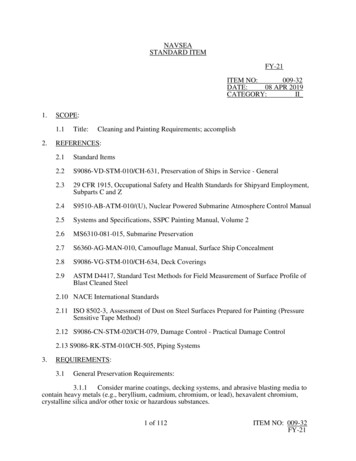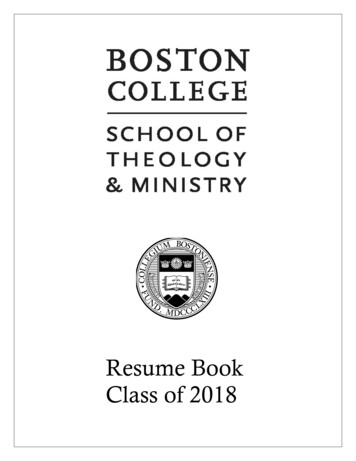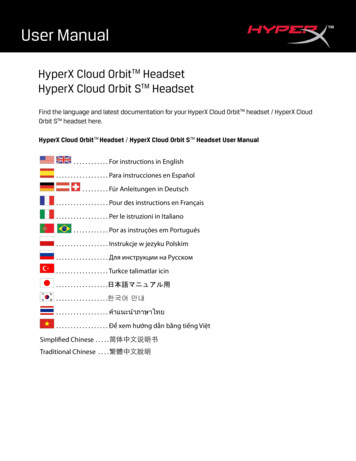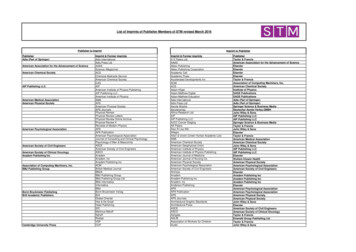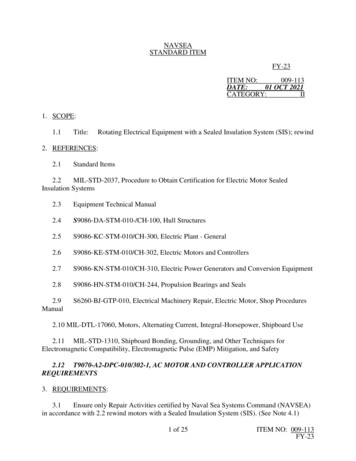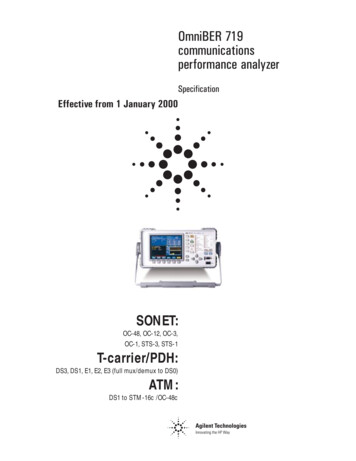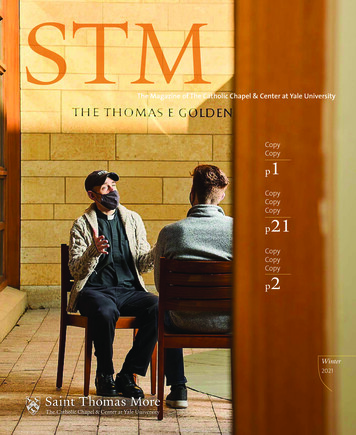
Transcription
STMThe Magazine of The Catholic Chapel & Center at Yale inter2021
STM MAGAZINE CONTRIBUTORSEditors:Writers:Robin McShane is the Directorof Communications at STM.Liam Callanan '90 is the author of Cloud Atlas(2004), and, most recently. Paris by the Book (2018).He is a Yale graduate, a Yale parent and the 2017George W. Hunt, S.J., Prize winner.Sarah Woodford '10 M.Div.is a graduate of Yale DivinitySchool and STM’sLibrary Director.Carlene Joan Demiany '12 M.Div., '14 S.T.M. is oneof STM’s assistant chaplains. Her primary focus isUndergraduate programming.Meagan Fitzpatrick Ph.D. '14 lives in Marylandwith her husband and two sons. She works at theUniversity of Maryland School of Medicine.Design:Christopher Gurley GRD '21 is a graduate studentat Yale Divinity School.Primary Photography:Gregory Jany '21 is a senior in Jonathan EdwardsCollege.Cadwell Art DirectionRobert A. LisakIn This IssueMaria Mendoza '23 is a sophomore in Ezra StilesCollege and a member of STM’s UndergraduateCouncil.Paul Meosky GRD '22 is a student at Yale Law Schooland a frequent contributor to STM’s blog.Katie Painter '23 is a sophomore in Timothy DwightCollege and a member of STM’s UndergraduateCouncil.Valerie Pavilonis '22 is a junior in Morse College anda member of STM’s Undergraduate Council.13STM MAGAZINE SPRING resS TAY I N T O U C HAbout the CoverNew copyWITH STMMission StatementSaint Thomas More Chapel & Center serves the Catholic community at Yale by:· Creating a vibrant and welcoming community through worship and serviceDownload the STM Yale App.5192728THREE QUESTIONSPOP! CULTUREOPEN BOOKSNAP SHOTSTM Magazine is published twice a year for ouralumni, parents and friends. Opinions expressedin this magazine do not necessarily reflect thoseof the entire STM community.The light shines in the darkness andthe darkness has not overcome it .· Cultivating informed faith and spirituality· Engaging in reflective discourse on faith and culture· Advancing the Church’s mission of promoting social justice268 Park Street, New Haven, CT 06511-4714· Participating in the global Church’s life and witnessPhone: 203-777-5537Fax: 203-777-0144stmchapel@yale.eduFollow us online: stm.yale.edu– John 1:5
STUDENTFROM THEChaplain’s Desk“”VOICESHeadline:SubheadNew calloutWriter 'Year“Todaysalvation has come to this housebecause this man too is a descendant of Abraham.For the Son of Man has come to seek and to save what was lost”Dear Friends,(Luke 19:10).New copySo concludes this Tuesday’s moving gospel passage in which thetax-collector Zacchaeus repents of his sins and gives himselfover to God at last. As I immerse myself in these words, the sunis setting on another short November day outside my window.COVID-19 cases are continuing to surge around the country. My(remote) sophomore fall is drawing nearer to its end and I feelmy former life on campus receding deeper into the folds of mymemory. And yet, despite these sorrows, the gospel invites aflame of hope into my cloistered, lamp-lit bedroom tonight.We live in a sick, hurting and broken world. Once again at thismoment within the ebb and flow of time, we face a swell ofhuman suffering. We might find it easy to distance ourselvesfrom God as we come to terms with the darkness in our midst.Overwhelmed by the uncertainty that lies ahead, we might be allthe more tempted to stray from Christ’s path. As people of faith,however, we must engage with the voice of conscience. We mustconfront ourselves with all we have done and failed to do, as we look upon a world that needs our help. Of course, it can bedifficult to acknowledge our painfully human shortcomings. A sense of despair might threaten to wrap its tendrils aroundour hearts and choke out the joy of Christ’s love that we are called to radiate.Re-create this photo with a shot ofFr. Ryan from further away (duringvirtual Mass); add play buttongraphic on top of new photo.Gratefully Yours in Christ,Fr. Ryan M. LernerChaplain1.But Zacchaeus’ story reminds us not to dwell on the imperfections of earthly life. Instead, the gospel tells us that we mustturn to our faith to heal, to examine our faults with an unflinching eye, and thereby cultivate the very best versions ofourselves in God. We come to our Father as we are. We confess our sins with our hands empty and heads bowed. And yet westrive every day to live more in God’s image, to be better than we were the day before, to come closer to the life that Christteaches. Perhaps we will never attain the unblemished ideal to which we aspire. We are all, as Jesus says, “what was lost.” Butif we really try to channel God’s redeeming grace in everything that we do, we can also be what was found.As some say St. Augustine once proclaimed, “The Church is not a hotel for saints, it is a hospital for sinners.” These words havebreathed life into my thoughts over the past few weeks, as I have grappled with the flaws that I see both in myself and in theworld I inhabit. I hope that our Christian family will cherish the wisdom of Augustine and Zacchaeus as we move forwardinto the newest chapter of the Church’s history. Let us keep our faith grounded in the promise of healing, redemption andrenewal for all.Photograph by Carlene Demiany2.
Fr. Bob’s Final Project:Realizing the Frederick Shrady Statueof St. Thomas MoreCarlene Joan Demiany, '12 M.Div., '14 S.T.M.Fr. Bob sat directly across from me, hands folded, inquisitiveeyes alive with purpose. I sat in my desk chair, notepad inhand, pen at the ready. It was fall 2017. He wanted to meetto discuss projects he hoped to complete before ending histenure as Chaplain.Our conversation turned to his last, unfinished project:the realization of a Frederick Shrady statue of St. Thomas More.I scribbled down notes, as he shared the intriguing history.It was 1999. He and Kerry Robinson M.A.R. '94 had justbegun their capital campaign to build what would becomethe Golden Center. One of the first gifts received camefrom Daniel McKeon of Ridgefield, CT, who happenedto be a neighbor and friend of Frederick Shrady,arguably the preeminent Catholic sculptor ofrecent history. He holds this distinctionprimarily because he is the only Americanartist ever commissioned by a Pope. Histwelve-foot statue of Our Lady of Fatimarequested by then Pope John Paul II stillresides in the Vatican Gardens.After receiving Mr. McKeon’s pledge, Fr. Bob and Kerry met with Frederick Shrady’s widow,Maria Shrady, who showed them her late-husband’s maquette of St. Thomas More. Famousfor an artistic technique called “bronze in motion,” Shrady’s statues are purposefully abstractin order to focus the viewer’s attention on the movement of the figure. This technique invitesthe viewer to look past physical attributes and ask what the movement reveals about theinternal disposition of the figure. This artistic technique had a memorable impact on Fr. Bob.“I’ll never forget that maquette,” Fr. Bob said to me in our meeting. “St. Thomas More isleaning back. This is the moment when King Henry VIII is yelling at him. He is bendingunder the pressure and looking up to heaven for strength. The question is: will he break, willhe recant or will he stand firm?”Unfortunately, Mr. McKeon died in 2001, shortly followed by Maria Shrady’s death in2002. Attention turned to the ambitious construction of the Golden Center with the intentof realizing the statue at the conclusion of construction. Yet by the time this occurred, theproject stalled due to the deaths of the statue’s biggest advocates: Mr. McKeon and Mrs.Shrady. When Mrs. Shrady died, the whereabouts of her late-husband’s maquette becameunknown.“We need to find that maquette,” Fr. Bob said, giving me one of his famous winks.“I want to get this done. It is important.”Despite my initial attempts to find the maquette, I was unsuccessful. But when Fr. Bob wasdiagnosed with brain cancer in January 2018, the project became an obsession. I wanted himto know his final unfinished task would be completed. Fortunately, at that time we welcomedMargaret Lukaszyk as Director of Development. She joined in the quest with a newperspective and began following new leads. A series of phone calls eventually connectedMargaret with the artist’s daughter Maily Smith. Once in contact with Mrs. Smith, Margaretexplained the history and need to find the maquette. After searching through her father’sestate, Mrs. Smith believed she had located the long-lost maquette in her brother’s NorthernVirginia home.“This spring, Fr. Bob's final wishwill now be fulfilled,when a life-size Shrady statueof St. Thomas More is installedin the Residence Garden.”I took the photos Mrs. Smith's brother sent to Fr. Bob so he could verify it was the maquettehe had seen with Kerry in 1999. I went into the residence and found Fr. Bob in his wheel chair,covered in his Yale blanket. At this point, talking and smiling were difficult, as the aggressive brain cancer progressed.I sat down and shared the good news that Margaret might have located the lost Shrady maquette of St. Thomas More. I held upthe photos directly in front of him.When Daniel McKeon made his gift,he pledged half to the building campaignand half to the realization of aFrederick Shrady statue of St. ThomasMore. Prior to his death in 1990,Shrady had produced a sixteen-inchmaquette (a preliminary model) of apossible St. Thomas More statue.Never before cast as a life-sizesculpture, Mr. McKeon wantedthis dramatic maquette realized andon display at what would becomthe Catholic Center at Yale.3.“You found it,” he managed to say, lips curving, wanting to smile. “I am happy.”This spring, Fr. Bob's final wish will now be fulfilled, when a life-size Shrady statue of St. Thomas More is installed in theResidence Garden. With its realization and installation, we are adding to the art historical record of Frederick Shrady, expandingthe repertoire of a prominent, deceased Catholic artist. We also join a prestigious list of other museums and institutions that havea Frederick Shrady statue in their collections, a list that includes, but is not limited to the Vatican Gardens, the MetropolitanMuseum of Art, Stanford University, the J. Edgar Hoover Building and St. Patrick’s Cathedral.When the statue of St. Thomas More is installed, viewers may find it imposing and haunting. The hollow eyes of the saint staretowards heaven, as he leans back, grasping his crucifix. This is the moment when King Henry VIII is forcing him to choosebetween family, prestige, his very life or the dictates of conscience. Shrady is inviting us into that haunting, terrible choice.Would we, the viewer, have the same strength not to bend under the pressure or would we break and compromise? As wecontemplate the statue, Shrady invites each of us to question our own courage.With special thanks to Cristina Demiany, M.A. Art Business, for her artistic contributions and commentary on this article; Margaret Lukaszyk, forspearheading the project; and Kerry Robinson, for her historical knowledge, passion and support.14.
FAITH IN THER E A LW O R L DA Place with Fewer TearsMeagan Fitzpatrick Ph.D. '14In this feature, a STM alumna/us reflects on joys and changes in their faith life after graduation. If you are interested in beingone of our feature writers for “Faith in the Real World,” we would like to hear from you. Contact robin.mcshane@yale.edu.In more ordinary times, in the before-times when the word “COVID-19” had not yet entered ourlexicon, I found inspiration and motivation for my work in this reading from Isaiah:“On this mountain he will destroyThe veil that veils all people,The web that is woven over all nations;“ Th e L ordGODwillw i pe aw ayt h e t earsf romev er y f ace.”He will destroy death forever.The Lord GOD will wipe away the tears from ever y face.”This vision has been the cornerstone of my image for the Kingdom of God. And while I acknowledged thatdeath could never be fully destroyed, I chose a career in public health with the hope that my work could bringthe world closer to the Kingdom –a place with fewer tears and a less-tightly woven web.Enter 2020.I should clarify further: I am an infectious disease epidemiologist. Almost every day this year, I have beenworking with COVID-19 data, evaluating how bad the pandemic has been and computing what is likely tohappen next. With this work, I have been in the position of seeing the near future with striking clarity buthaving almost no power to change it. It is a position that easily breeds despair. Why work so hard? asks acynical inner voice. You cannot beat this thing. Let the world take care of itself. Death always wins, it’s just winninga little faster now. What does it matter?For me, the only response is through the hard Truth at the center of Christianity: that Jesus Christ diedand rose from the dead. If we believe this, we also believe the corollary that there are things morepowerful than death, that death is not the full story, that we are indeed called to transcend death.In Christ, there is no room for cynicism.I remember, too, that even Christ did not heal all those who were sick when he lived on Earth.He healed those in front of him, and it was counted a miracle.And so for one more day, I turn back to my computer. Death is here – the data shows thatclearly – but it does not have to win. Little by little, we work to loosen its web.5.Dr. Fitzpatrick is an infectious disease transmission modelerat the University of Maryland School of Medicine. She lives inMaryland with her husband and her two sons.6.
Challenge and Hope in a Pandemic:Virtual Brunch with Cardinal TagleWriter 'YearLast November, members of the STM community gathered fromaround the world for a virtual brunch with Cardinal Luis AntonioGokim Tagle. The former Archbishop of Manila, Cardinal Tagle is thecurrent prefect of the Vatican’s Congregation for the Evangelizationof Peoples, which oversees the Catholic Church’s work in Africa, Asiaand Oceania. He also serves as President of Caritas International, aglobal confederation of over 160 grassroots Catholic charities andorganizations, and as President of the Catholic Biblical Federation.Cardinal Tagle reflected on the pandemic as a mirror on the state ofhumanity, as it confirms the deep inequities and cracks in society. Noteveryone has experienced the pandemic equally. He exclaimed that “itfeels like an insult” to tell those without access to water to wash theirhands, or those without homes to stay at home. He challenged thoseof us who dream of going back to “normal.” He asked: “You call thatnormal?” Our world is one where refugees flee from war, poverty and natural disasters. As Christians, Cardinal Tagle believedthat we could envision a new post-pandemic future through a “humble, honest and even painful examination” of ourconsciousness and lifestyles done in prayer and in light of the Word of God.In many ways, Cardinal Tagle’s talk reflected on the themes of Pope Francis’s third encyclical, Fratelli Tutti, which called forhuman fraternity and solidarity. Cardinal Tagle reminded us not to be blind to the “closed worlds”—the divisions in oursocieties, families and communities—in a reference to the encyclical’s first chapter, “Dark Clouds Over a Closed World.”Cardinal Tagle also highlighted the specks of hope that emerged out of the pandemic. We find hope in the “good, heroic andChrist-like” work of doctors, nurses and volunteers. The Catholic Church remains resilient as its missionaries find new ways tocontinue their work. The pandemic might have even offered opportunities to rediscover family life and to review lifestyles andpriorities.Moved to tears at one point, Cardinal Tagle remindedattendees that they all still possess the power to spreadhope. Even a few sincere words or a telephone call to thesick and dying are “expressions of communion andexpressions of nearness” that can let them know that theyare remembered.The pandemic continues to rage on, and stories of loss,division and injustice arise daily. But Cardinal Tagle’sreflections offered hope. He ended his talk with acall to continue in our deep communion with the wholeof humanity and creation. As Cardinal Tagle emphasized,“every sincere act of love and communionmakes a difference.”7.P O P !C U LTU R EHeadline:SubheadPaul Meosky GRD '22Every time a TV episode opens in a church,you know it’s going to be a good one. If the CW Networkis anything to go by, your chances of being ritualisticallymurdered skyrocket when under the watchful eyesof stained-glass saints and sculpted cherubim.You know you’re really in trouble when you starthearing carols and sleigh bells. Don’t call “hello,”don’t investigate the fourth pew on the left and don’tgo anywhere near the altar. Just. Run.The new Netflix show EVIL puts this trope front andcenter as an atheist psychologist teams up with a buffseminarian to investigate possessions, prophets and thelike. Faced by the inexplicable, both must confrontcracks in his faith and her science. The twenty-firstcentury viewer knows those cracks are easily filledwith the magic of CGI and imaginative scriptwriting,but as we look past the special effects, we see the show’snamesake isn’t so much hell’s fury as earth’s pettiness.The real demons aren’t Lucifer and Beelzebub but thevanity, prejudice and suspicion that unleash our own worst instincts.At this point, you’re probably scanning the magazine dateline and wondering where a horror TV show fits intothe Advent issue. A little blood and gore is all very well, but we have rules for this sort of thing. No carols beforeHalloween, no monsters thereafter. Mixing the two, as TV producers know, is jarring – but also enlightening.The Christmas episodes are the best because they remind us that peace on earth, goodwill to men isn’t a givenbut a mission, something we must fight for year-round. We see our dynamic duo solve the mystery, slay themonster, set the world right – but only for a few and only for a moment. Tomorrow will bring new atrocities,and meanwhile, just a little off-screen, families mourn and slowly, slowly heal.We all deserve a little comfort and joy in the coming weeks. However, I also wish you the discomfort youneed to grow and the dissatisfaction you need to make a lasting change this Advent and beyond. Don’t letthe Christmas lights blind you and don’t let the carols lull you into thinking all is right with the world.The monsters are still here, and it’s up to us to magic some miracles. ‘Tis the season.8.
#MyCatholicYale
Illuminating what Lies Beneath:2020 Hunt Prize LectureAmerica only works, she added, if very different people are able to live, work, and vote together. But the seeminglyprevailing “us versus them” mentality can block these efforts and usher in a chaotic wavering of the line between civic dutyand the search for the good life.Valerie Pavilonis '22On November 26, 2020, a plea for unity and repair appeared in the New York Times, written by Pope Francis as part of hisnew book. “This is a moment to dream big, to rethink our priorities — what we value, what we want, what we seek — and tocommit to act in our daily life on what we have dreamed of,” Pope Francis wrote.On October 9, 2020, Emma Green gave her acceptance speech and talk for the 2020 Hunt Prize atthe America Media offices in New York, NY. The talk would be released later in the fall. The audiencewas sparse, made up of those taping the event and Father Matt Malone, S.J., President and Editorin-Chief of America Media and Father Ryan Lerner, Eighth Catholic Chaplain at Yale University.Outside, Sixth Avenue was quiet—completely void of cars. Green spoke about the realities of thepandemic in a talk very much affected by it.Though she spoke several weeks before Pope Francis, Green’s parting message had a similar message: Perhaps a small giftof this pandemic is that despite our disruptions, we have greater liberty to experiment with new forms of living —and community.Watch the 2020 George W. Hunt, S.J. Prize lecture by journalist Emma Green: https://www.youtube.com/watch?v X0dG4DtO790Read Pope Francis' New York Times Opinion article:Pope Francis: A Crisis Reveals What Is in Our Hearts ancis-covid.htmlFor Emma Green, staff writer atthe Atlantic and 2020 laureate ofthe George W. Hunt, S.J. Prizein Journalism, the COVID-19pandemic has made life feel “stuck.”But while the virus has crippled therhythms of everyday life in Americaand abroad, it has also illuminateddeeply-carved divisions andtightly-wound tensions —the cures to which may lead toa better society down the road.Green’s talk wove all of these characteristics together in a portrait of American life, seen throughher personal lens at the intersection of faith and politics. No matter a person’s faith or religioustradition, Green said, the dominant thought in every person’s mind is, simply, how to live a goodlife. And it is her job as a journalist is to keep a record of how individuals and their communities tryto figure out how they wish to live.Still, Green said, the past months have seen this path to a good life become obscured, as thepandemic has revealed vast wounds that fester across the American social landscape. And aspolitical polarization winds tighter and tighter, many Americans feel increasingly squeezed outfrom the institutions they once loved and depended upon.“In many parts of American life, people feel that the institutions that were supposed to guard ourlives and guide our lives have failed, and there’s no space for people like them,” Green said. “Theresult, which I see in my reporting all the time, is a widespread sense of mutual mistrust.”11.12.
Illuminating what Lies Beneath:2020 Hunt Prize LectureAmerica only works, she added, if very different people are able to live, work, and vote together. But the seeminglyprevailing “us versus them” mentality can block these efforts and usher in a chaotic wavering of the line between civic dutyand the search for the good life.Valerie Pavilonis '22On November 26, 2020, a plea for unity and repair appeared in the New York Times, written by Pope Francis as part of hisnew book. “This is a moment to dream big, to rethink our priorities — what we value, what we want, what we seek — and tocommit to act in our daily life on what we have dreamed of,” Pope Francis wrote.On October 9, 2020, Emma Green gave her acceptance speech and talk for the 2020 Hunt Prize atthe America Media offices in New York, NY. The talk would be released later in the fall. The audiencewas sparse, made up of those taping the event and Father Matt Malone, S.J., President and Editorin-Chief of America Media and Father Ryan Lerner, Eighth Catholic Chaplain at Yale University.Outside, Sixth Avenue was quiet—completely void of cars. Green spoke about the realities of thepandemic in a talk very much affected by it.Though she spoke several weeks before Pope Francis, Green’s parting message had a similar message: Perhaps a small giftof this pandemic is that despite our disruptions, we have greater liberty to experiment with new forms of living —and community.Watch the 2020 George W. Hunt, S.J. Prize lecture by journalist Emma Green: https://www.youtube.com/watch?v X0dG4DtO790Read Pope Francis' New York Times Opinion article:Pope Francis: A Crisis Reveals What Is in Our Hearts ancis-covid.html"America only works.For Emma Green, staff writer atthe Atlantic and 2020 laureate ofthe George W. Hunt, S.J. Prizein Journalism, the COVID-19pandemic has made life feel “stuck.”But while the virus has crippled theif very different peopleare able tolive, work, and vote together."Emma Greenrhythms of everyday life in Americaand abroad, it has also illuminateddeeply-carved divisions andtightly-wound tensions —the cures to which may lead toa better society down the road.Green’s talk wove all of these characteristics together in a portrait of American life, seen throughher personal lens at the intersection of faith and politics. No matter a person’s faith or religioustradition, Green said, the dominant thought in every person’s mind is, simply, how to live a goodlife. And it is her job as a journalist is to keep a record of how individuals and their communities tryto figure out how they wish to live.Still, Green said, the past months have seen this path to a good life become obscured, as thepandemic has revealed vast wounds that fester across the American social landscape. And aspolitical polarization winds tighter and tighter, many Americans feel increasingly squeezed outfrom the institutions they once loved and depended upon.“In many parts of American life, people feel that the institutions that were supposed to guard ourlives and guide our lives have failed, and there’s no space for people like them,” Green said. “Theresult, which I see in my reporting all the time, is a widespread sense of mutual mistrust.”11.12.
Innate Dignity:The Reverend Robert L. Beloin Lecture on Contemporary TheologyChristopher Gurley GRD '21Dr. Katie Walker Grimes, Associate Professor of Christian Ethics at Villanova University, gaveThe Reverend Robert L. Beloin Lecture on Contemporary Theology at STM in November. In herlecture, she explored the evolution of Catholic thought on slavery, individualism and freedom as seenwithin the context of the U.S. Catholic position on abolition and the American Civil War. Dr. Grimescontrasted Catholic social teaching with the moral philosophy of Fredrick Douglas, one of the mostinfluential Black abolitionist voices of the Nineteenth Century. Her lecture brought to light notsimply the differing positionalities of Catholicism and abolitionism, but the starkly different worldsin which each sough to manifest.The worldview of nineteenth-century Catholic social teaching sought to sustain a hierarchical social reality of duty andresponsibility. This hierarchy stressed a creation of a “social order” in which we are bound to each other and God througha relationship of obligation. Dr. Grimes portrayed this hierarchy of obligation by stating that in this social order: “children[are] responsible to their parents, wives responsible to their husbands, slaves responsible to their masters, and human beingsresponsible to God.” The world in which Douglas sought to create began not with the creation of hierarchy, but the innatedignity of the individual. Douglas rooted his reconstructive vision of social order in a radical embrace of individualism, thatis the elevation of self-ownership and self-determination of all peoples—the rejection of perverse hierarchical obligation.However, paradoxically, the point of unity and contention that bound together these drastically different worlds was thequestion concerning the role of governance. How is one to live in this life? To whom are we responsible to in this life?What is the governing voice within our lived experience?As contemporary Catholic social thought reflects much more the sentiments of Frederick Douglas, the question provoked ofthe U.S Catholic Church is: What is Catholicism’s place within the liberation of Black and other marginalized peoples? Likeabolition, this question garners a myriad of responses from white and white ethnic Catholics across the political spectrum.However, as a millennial Black Catholic from the Deep South, I have faith that the radical embrace of the innate dignity of allpeoples will prevail. Maybe not in my lifetime, but one day."I have faith thatthe radical embraceof the innate dignityof all peopleswill prevail."Christopher Gurley GRD '2113.14.
Donor RecognitionSaint Thomas More Supporters 2019-2020Many thanks to all those who contributed to STM last fiscal year. Without your support, we would not be able to fulfillour mission and minister to the growing number of Catholic students on campus.This list represents donors who have made gifts to STM between July 1, 2019 and June 30, 2020.Lorenza and Gabriel AbaroaPatricia Keegan AbelsDenise AcamporaNancy AdamsApril Adams-Johnson and Dirk C.JohnsonRobert David AddamsAlbertus Magnus CollegeLaura Aldir-Hernandez and Dr.Hector N. HernandezLynda and Peter AlegiA9Patricia AlejandroMary Lou Aleskie and PeterWebsterRev. Patricia P. AlexanderAlfresco Landscaping & Design LLCRichard F. AllenLaura Donahue Allen and RobertW. AllenDr. and Mrs. John M. AmatrudaCatherine AmayaDrs. Stephen Anderson and TaraToolanAnn F. AnestaMrs. and Mr. Joan AntonelliWilliam F. AppicelliHonorable Paul V. ApplegarthDr. Michael L. J. ApuzzoArchdiocese of HartfordArchbishop's Annual AppealMartha and James ArdenRosemarie and John J. ArenaJohn B. and Catherine ArmitageCeleste AsisKathleen and Anthony W. AsmuthIIIJanis and Harold AttridgeMr. and Mrs. Paul F. AubinBaby King ManagementAnnette and Homer M. BaileyJanice P. BaileyBenjamin F. Bain IIIVirginia and Charles BaltayCarmen B. BambachMary BarnesJennifer L. BarrowShannon and Michael J. BarryJohn and Belinda BattistaRev. John P. Beal IIIDavid P. Bechtel and Dr. Kristen A.BechtelKelly Thomas BeeCharles Beirnard and AntoniaMorasGail Thibaudeau and Art BellucciJohn S. BentleyMargaret A. BercovitzDr. Edmond BergerDr. Juan D. Bermudez and KristineKayser-BermudezMichael D. BeuggDeacon Frank Bevvino15.Marilyn and Jonathan E. BillingsValerie and George BillyFred and Janna BinderSandra J. Bishop and Robert JosefDr. and Mrs. O. Joseph BizzozeroDouglas A. BlackAndrew BlackEdwin J. BlairCarol A. BlakesleeBrigid BlakesleeAlyssa BlissM. Jennifer BloxamMartin J. and Julie M. BolandDr. Harold D. Bornstein, Jr. Nancy and Peter L. BorowskiAnne M. BoucherRobert A. BourgeoisF. Richard BowenRobert Bowen, Jr.Mary Elizabeth BowermanJohn J. and Marguerite BowesDavid T. BoyleJennifer and Roberto M. BracerasNicholas F. BradyDeirdre and Theodore E. BraunRobert P. BreaultDr. Bruce T. BrennanJudith and Thomas J. BrennanAnne and James J. BrennanLiam
For the Son of Man has come to seek and to save what was lost” (Luke 19:10). So concludes this Tuesday’s moving gospel passage in which the tax-collector Zacchaeus repents of his sins and gives himself over to God at last. As I immerse myself in these words, the sun is
